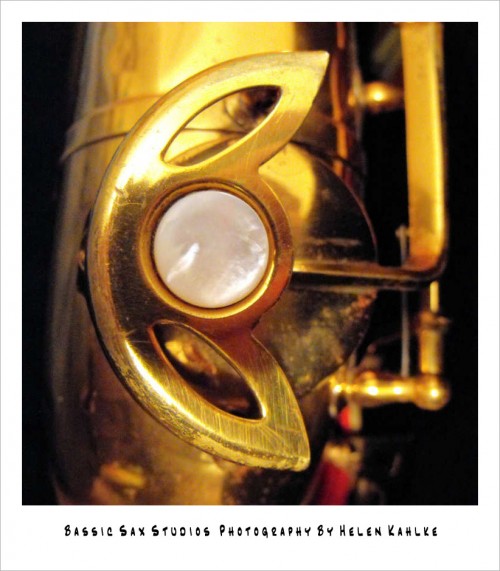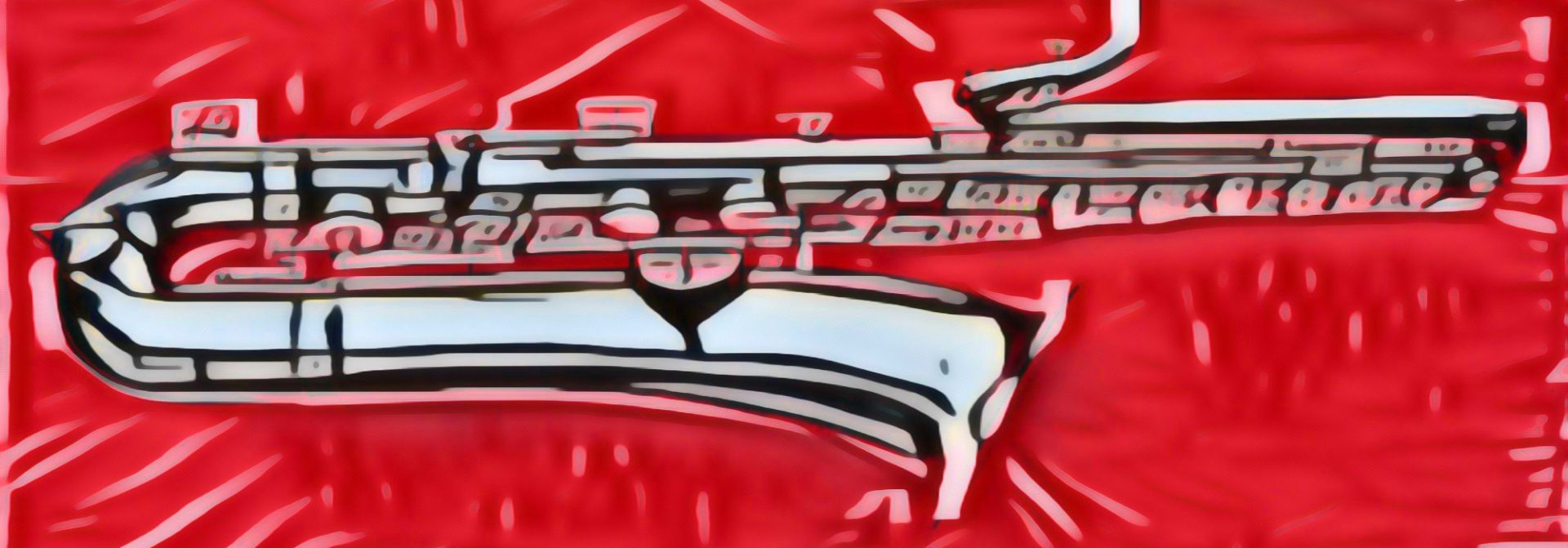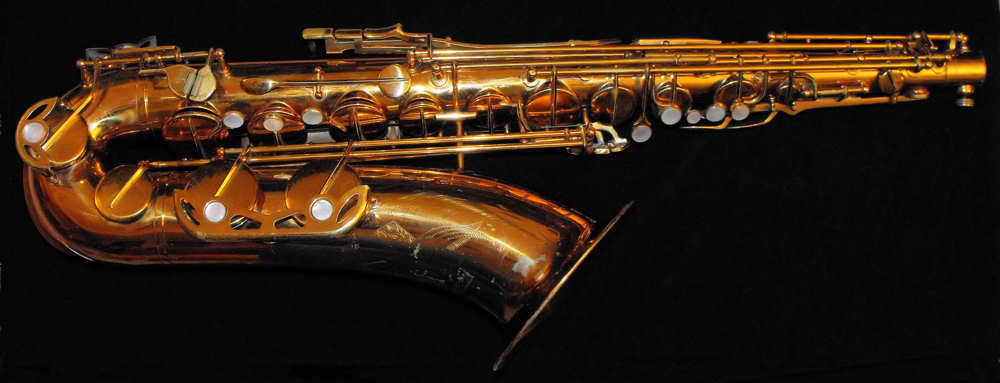 Now that I’ve had just over a month on this sax, on Wednesday night I decided to take my Dörfler & Jörka to rehearsal again to see what it could do up against the electric guitar sounds of Art Panchishin. Well, for a vintage, dark, 1950s German saxophone, this Keilwerth clone really was able to hold its own.
Now that I’ve had just over a month on this sax, on Wednesday night I decided to take my Dörfler & Jörka to rehearsal again to see what it could do up against the electric guitar sounds of Art Panchishin. Well, for a vintage, dark, 1950s German saxophone, this Keilwerth clone really was able to hold its own.
The D&J has a richness in its bottom end that I haven’t found in any of my other tenors—Mark VI, Martin Handcraft, or 10M—although the Martin comes the closest. The sax has an overall fullness in tone that is able to project through the electronic “noise” of the electric guitar and bass. And although not particularly useful with this band, the D&J subtones down to low Bb easier than any of my other tenors. It’s literally effortless.
Since I currently only play in 1 band, I play very little in the bottom octave of my horn. With Deception, I play mostly in the 2nd octave and up into the altissimo, and regularly duel with the guitar in solos. I was curious whether or not I would be able to use the D&J as a back-up horn for Deception, if for some reason my Selmer was not available. After this week’s rehearsal, I would say that the D&J would make a fine back-up horn.
I will have to spend some more time on the D&J to get familiar with its idiosyncrasies, because it does have some. So far the largest hurdle that I’ve encountered is that my standard fingering for F#3, the one that I use on all my horns, plays 50 cents flat. I need to find a new fingering for that note on the D&J.
The front E and F play perfectly in tune however, so that’s a good thing. I’ll do some experimenting in the next day or 2 and see what I can come up with to bring my F# up to pitch. The rest of the altissimo notes I use seem to be OK, but then I don’t use all of them in Deception. I will have to check the full altissimo range to see if the D&J has different fingering preferences for other altissimo notes as well.
Because I use a lot of effects when playing with Deception, such as growl tone, flutter tongue, false fingerings, bends, slides, scoops, multi-phonics, and other distortion effects that come from my throat and embouchure, I prefer saxes that allow me to play these effects as effortlessly as possible. It seems to me that the ease of some of these effects is directly proportional to the amount of resistance in the horn. The less the resistance, the easier certain effects speak.
Of all my tenors, the Conn is the easiest to tease effects from, the Martin is next, and the Selmer is the hardest. This D&J is comparable to the Selmer, in that the amount of resistance from the horn is about the same as the Selmer.
The D&J really surprised me on Wednesday night. I did not think that this dark sounding horn (compared to my other saxes) would be able cut through well enough, to be useful in an electric blues environment. I did put my brightest Dukoff, an S7, on the horn, and that helped a lot. Anything less, and I don’t think the results would have been the same.
I am currently working on an article about Dörfler & Jörka saxophones. I am trying to compile as much info as I can from around the ‘Net, and hope to have it published in the next month. If you have any info you’d like to share about the Dörfler & Jörka saxophone company, please get in touch with me. Thanks!




Yes, I meant the front F fingering + the side Bb key. That works well on my horns. If it’s a bit flat, I don’t notice it. I might just naturally be lipping it up after all these years.
Having a doctor that plays sax is a wonderful find! I bet you might get an unsolicited bit of advice next visit — like “you said you have this problem, so I was mucking about with this alternate technique and it might help you”. Also, he or she will understand why you continue to play through it even when it’s not always pleasant or pretty. We all hit times when nothing seems to work right, even without physical ailments. I would be surprised if your doctor was any different.
I have a front F on my C-mel, which I made out of one of the palm keys off my Yamaha tenor “parts horn”. It looks a bit odd (mostly because the posts are gold and the key is chrome, while the horn is silver) but it works as well as it needs to. It feels just fine, better than most factory-equipped “pearl button” front F keys. It’s one piece rather than two, but so is the stock front F on my Dolnet bari and it also works just fine.
Still, front F plus side Bb doesn’t produce F# for me — unless you meant front F+LH2+side Bb (that is, high F fingering plus side Bb). This runs really flat on my tenor, but front F+bis Bb+side Bb is passable. It’s just not very accessible since I end up with THREE fingers out of position as a consequence. 1 – 3|1 – – doesn’t take ANY fingers out of position. If the intonation is not acceptable, muck about with pinky keys (both hands) and/or the fork-F# and you’ll probably find a combination that works.
Sometimes I adopt a preferred fingering that is not the best sounding or most in tune, but rather the one that I can get to without tying my fingers in knots. I’ll use the awkward one if I need to sustain the note, but that’s also the case in the normal range, with “resonance fingerings” and the like. Other times, there is only one way to get a note, like it or not.
I don’t know what your normal F#3 fingering is, but I’ve had pretty good luck using 1-3|1– on just about everything but my alto (which has an F# key) and soprano (which has both F# and G keys). G3 is the one that seems to be different (and difficult) on every horn. For G3, The Yamaha tenor and Dolnet bari both like 1-3|1– plus side C, but this runs a little sharp, and very sharp on the C-mel (for which I fitted a key that only cracks open the side C a millimeter and a half). G#3 is 123|— plus side C, and A is -23|— with or without the G# depending on the horn (except bari where everything over G# is hideously flat — I can manage A and Bb, but that’s all).
These are not necessarily the BEST fingerings for each note on a given horn but they do seem to work across all of them with minor variation, and they are similar enough to each other to make for relatively easy technique. In particular, my C-mel really likes 1-3|1–Eb, fork-F#, and side C barely cracked as a fingering for G3. It’s the most stable, easiest to nail, and has passable intonation. Unfortunately, it’s also a complete b!+ch to move to/from, so I rarely use it.
We may be coming at this from opposite directions, as I am not much of a tenor player (though I’m improving), preferring to play alto when that range is required. The acoustics of alto and tenor are not incredibly different, but what differences there are seem to affect F#, G, and G# the most. You, on the other hand, are probably approaching this from your time on a modern tenor (I consider the Mark VI to be the first modern tenor, as everything since seems to be cloned off it to some degree), and are finding the vintage horns have their oddities. You’ve already accepted that it won’t respond the same as the Selmer, but it MIGHT respond similarly to something else you’re comfortable with — that just might not be a tenor.
I’m sure I’ve been driving the neighbors nuts lately, since I’m trying to get the C#4 to F4 range locked in on my C-mel. I hope you have enough space to not have this problem. 🙂
I say F!@# my neighbors! :devil2: Just kidding… I live in my own house, so I have no problems. The pet rabbit and the dog are not too fond of my practicing however. I have been accused of “chicken choking”… That is what my housemate calls my altissimo practice… But I digress…
I’m real old school when it comes to F#3… I do Front F and add side Bb. It works on all my tenors, including my Martin Handcraft that had a YTS-23 front F key added. I’ll try your fingering, this weekend. I haven’t had the time to even play my horn since rehearsal.
BTW, I totally agree with you about the Mark VI being a modern horn. It will be will interesting when I get the Zephyr later this summer, since that will be a different animal again. Vintage, but not like anything I currently have.
Since I currently can’t play alto or soprano due to the increased intracranial pressure that they cause me, I am just happy that I can play altissimo on tenor. I have to be careful though. If I do too much, I can run into problems and develop too much breakthrough pain. Luckily my new neurologist is an alto saxophone player, and has a greater understanding of this particular situation than any of the doctors I’ve seen up to this point. My other docs have just looked at me, and while they might have understood it from a logical level once I explained things to them, my new doc (since Oct) got it right away with no explanation necessary.